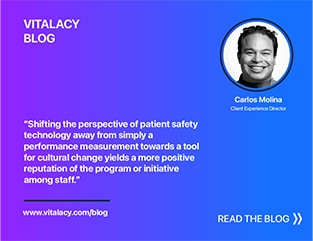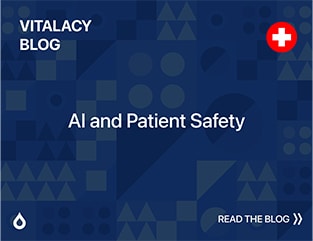A group of staffers at Virginia Mason Hospital in Seattle began what would turn out to be an eye-opening experience with a ball of blue yarn. They started unspooling it to illustrate the path a cancer patient would take on a typical visit for chemotherapy treatment. Their story is told in an episode of the 99 Percent Indivisible podcast, “The Blue Yarn.”

As the team moved the yarn across a cardboard map of the hospital’s interior, a visual story began to unfold that created a greater understanding of the patients’ experience among the staff. “When we looked at it, we were amazed at how far patients traveled,” said Michele Wettland, a nurse manager at the hospital. She described how the long walks caused shortness of breath among cancer patients, who have compromised oxygen capacity due to chemotherapy. “It was appalling to us,” she said.
The twisting journey involved going up and down elevators, walking through winding corridors, and waiting for long time periods at various times during the day. “We couldn’t conceive of it intellectually until we saw it visually,” Wettland said. “How awful it is for them,” said Dr. Henry Otero of the confusing path the patients had to navigate.
Bluetooth-enabled movement mapping provides insights into how workflow can be improved
Today, maps Illustrating the movements of people and things can be created through digital location and movement mapping technology rather than with a ball of yarn and cardboard.
Just as the blue yarn helped the Virginia Mason team to gain an understanding of what cancer patients experience, the Vitalacy team is using digital location and movement mapping to gain a better understanding of caregivers’ workflow and how it can be adjusted to improve patient experience and safety.
Gaining these workflow insights involves using Bluetooth, Internet of Things (IoT) and artificial intelligence (AI) technologies to gather data about where and how long care providers spend their time, with a particular focus on the time care providers spend interacting with patients face-to-face – the most important moments in health care. The data are visualized in real-time maps – an indoor version of a Google or Uber map.

The data gathered to create the real-time map also measure hand hygiene compliance, the consistency and effectiveness of nurse rounding, and the likelihood of nurse fatigue. By collecting and analyzing these data, unit managers can make adjustments to workflow to improve performance on these quality measures and enhance patient safety.
Care providers receive personalized reports on their individual performance; the reports provide feedback and engage the providers in the patient safety effort. Once they realize how the technology contributes to patient safety, their engagement increases even more.
More effective workflow leads to reduced healthcare-acquired infections and conditions
The Vitalacy Patient Safety Platform was recently implemented in about half the medical and surgical beds in an academic medical center with a higher-than-average healthcare-acquired infection rate. In less than two years, the platform enabled the medical center to improve the effectiveness of its hand hygiene program and thereby decrease healthcare-acquired infections, as described in Vitalacy’s white paper, “Finding New Ways to Prevent Healthcare-Acquired Infections and Conditions” (Vitalacy, 2019).
Collaborating with care providers was an important step toward overcoming objections to participation and compliance. By creating a multidisciplinary work group, the onsite Vitalacy team quickly found solutions to increase the care providers’ willingness to wear the tracking devices necessary for the location and movement mapping.
The work group meetings also served as an opportunity to introduce care providers to the mobile app that showed them, on a daily basis, their compliance rate compared to other individuals and units. “This started a fun competition between them,” remembers Tal Cohen, Vitalacy’s vice president of engineering. “They started to compare themselves to each other, which increased the awareness for hand hygiene and made the product more user friendly.”
The work groups also created the opportunity for broad multidisciplinary participation from as many departments as possible – for example, each patient care unit, infection control, facilities management, environmental services, nursing management, and more.
Refining the technology and, more importantly, engaging the staff significantly increased participation and compliance. And that’s where we saw a decrease in infection rates.
Movement mapping can improve the effectiveness of patient-caregiver interactions
Movement mapping will become more commonplace in our society, as this smart technology becomes even more integrated into mobile devices, vehicles, transportation hubs, shopping centers, and buildings including hospitals. As the technology advances, you’ll certainly notice when you’re in a building without it. The challenge for health care leaders will be using this technology to solve problems beyond parking and wayfinding.
Imagine a future when providers come to a hospital room before patients need to call for them, in which predictive algorithms tell caregivers when patients are likely to need assistance.
The potential for improving the effectiveness of patient-caregiver interactions is here. The answers to more effective workflow and health care are in the visualized data. As the team at Virginia Mason with the blue yarn found, the map tells a story you cannot conceive until you see it.
Janel Nour-Omid is Vitalacy’s Chief Product Officer
Request a demo of Vitalacy’s Automated Hand Hygiene Monitoring Solution today!
References
The Blue Yarn. 99 Percent Indivisible Podcast, Episode 30. July 1, 2011.
Vitalacy, Inc. Finding new ways to prevent healthcare-acquired infections and conditions. Mar. 14, 2019.
Author
-

Janel Nour-Omid was inspired to start Vitalacy after losing her grandfather to a Healthcare-Acquired Infection. Through her background in computer science and product development and deep fascination in human behavior, she launched the Vitalacy platform designed to protect caregivers and patients from preventable infections and conditions. She was recognized in Forbes 30 Under 30 in Healthcare in 2020.



